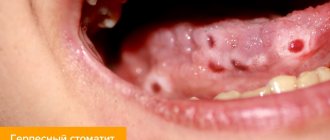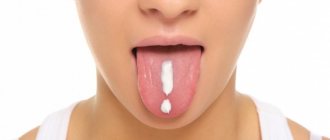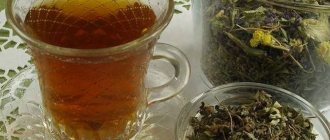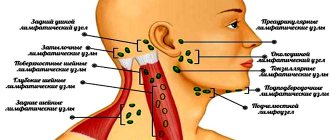Stomatitis is an inflammatory process of the oral mucosa, often of infectious or allergic origin. Stomatitis is one of the most common oral diseases in children of all ages, from infants to school-age children, although it can sometimes occur in adults. The special predisposition of children to this disease is explained by the fact that at a young age the mucous membrane of the oral cavity is more tender and thinner than in adults.
Types of stomatitis and causes of occurrence in children
The causes of stomatitis in children can be different, and they are directly related to the type of disease. In this section, we will look at the main types of stomatitis and their causes in children.
Herpetic viral stomatitis
This type of stomatitis is the most common and common. Sometimes this type of disease is simply called herpetic stomatitis or viral . Typically occurs in children aged 1 to 4 years.
Often infection occurs through airborne droplets. Infection with herpetic viral stomatitis is also possible through children's toys, dishes and other objects. Against the background of weak immunity, the virus enters the body and settles in the most damaged areas of the mucous membrane. Such places can serve, for example, as small wounds that appear after a child bites his lips.
Aphthous (allergic) stomatitis
This type of stomatitis is often also called drug stomatitis , since the main reason for the appearance of this type of disease is allergic reactions to various medications. It is impossible to say exactly which drugs can cause stomatitis; this is an individual predisposition, and can only be accurately determined by visiting a pediatric dentist after all the necessary diagnostics have been carried out. This type of disease occurs infrequently and, most often, in preschool children.
Traumatic stomatitis
As the name implies, this type of disease occurs after mechanical trauma to the child’s oral cavity and the entry of dirt and bacteria into these places.
Injuries can be of a completely different nature. This could be purely a dental problem. For example, due to an incorrect bite, a child may constantly bite his tongue or lips. Other types of mechanical damage to the mucous membrane include burns, for example, from food that is too hot, a pacifier that is too hard, various bad habits (pulling toys into the mouth, chewing a pencil, etc.).
Candidal (fungal) stomatitis
The main cause of candidal stomatitis is Candida fungi. Basically, this type of disease is typical for children under 1 year of age who are breastfed. Particles of mother's milk remaining in the baby's mouth after feeding provide an excellent environment for the development of this type of fungus. For this reason, sometimes this type of stomatitis is called thrush .
Infectious (microbial) stomatitis
The main reason for the appearance of infectious stomatitis in children is a decrease in immunity against the background of diseases such as tonsillitis, sinusitis, pneumonia and other diseases of the nasopharynx. This type of disease occurs in children of both school and preschool age. Infectious stomatitis develops especially often in the autumn-winter period, when the child’s immunity is weakened.
What it is
Damage to the oral mucosa can be caused in a variety of ways. In a healthy person, minor injuries disappear quite quickly and without leaving a trace. In the presence of chronic diseases that reduce the level of immunity, any infection or dirt that gets into the wound provokes the development of inflammation.
Traumatic stomatitis is the result of a single or long-term impact on soft tissues, as a result of which painful formations appear in places of damage that are not characteristic of the normal state of the mucous membrane. These may be small blisters, ulcers, erosions, ulcers or wounds covered with a grayish or white coating.
Most often, with a single exposure and the absence of infectious contamination, such consequences of injury disappear quickly and without drug treatment. If soft tissue injury occurs over a long period of time (by braces, a sharp tooth fragment, tartar, dentures, etc.), gum inflammation and stomatitis can develop into a chronic form.
Symptoms of stomatitis in children
Just like the causes of stomatitis in children, its symptoms are broad and also depend on the type of disease. In this section we will group the characteristic symptoms for each form of stomatitis in children.
Symptoms of viral stomatitis in children
The main symptom of viral (herpetic) stomatitis is the appearance of bubbles on the oral mucosa, which, after opening, form small erosions covered with plaque. Such erosions can be multiple in nature and located either at a distance from each other or merge together, forming large affected areas of the oral mucosa. They can be located on the lips, larynx, cheeks, tongue or roof of the mouth and are usually very painful and react strongly to touch, hot or cold food and other stimuli.
Symptoms of candidal stomatitis in children
Usually, before the onset of candidal stomatitis, the child experiences dryness of the oral mucosa, a burning sensation, an unpleasant taste and bad breath. Based on the baby's behavior, one can suspect the onset of the disease. As a rule, during this period, children are capricious while eating, behave restlessly, and sleep poorly. Further, as the disease develops, many small white dots appear, which form the affected area, covered with a white cheesy coating. In advanced forms of the disease, the plaque may turn gray. This indicates the transition of the disease to a severe form. In severe forms of candidal stomatitis, it is difficult to cleanse the mucous membrane of plaque and, at the slightest touch to the damaged area, it results in severe pain and bleeding.
Symptoms of bacterial (infectious) stomatitis in children
- The mucous membrane turns dark red; - The formation of yellow crusts occurs, which seem to stick together the lips; — The child experiences increased salivation; - Bad breath appears.
Also, depending on the infection that caused stomatitis, the following symptoms may be observed: the formation of fibrinous films, bleeding of damaged areas, severe plaque on the tongue.
Symptoms of aphthous stomatitis in children
With aphthous stomatitis, ulcers and aphthae form on the oral mucosa. Aphtha is a painful, round-shaped area of mucous membrane covered with fibrinous plaque. With aphthous stomatitis, children become lethargic, irritable, moody and complain of pain in the oral cavity. As a rule, aphthous stomatitis is chronic and can worsen 1–2 times a year.
Treatment of stomatitis in children
There is no single correct treatment for stomatitis in children. Treatment is selected individually for each child after visiting a pediatric dentist and greatly depends on the form of stomatitis. Depending on the type of disease, treatment may include both local and general therapy methods.
Despite the impossibility of selecting treatment for all types of stomatitis, there are a number of recommendations that should be followed for any form of the disease. During the course of the disease, it is recommended to adhere to a strict diet that excludes eating hot or too cold foods, as well as avoiding other foods that irritate the oral cavity. Particular attention must be paid to oral hygiene. After every meal, it is recommended to rinse your mouth. For rinsing, you can use special herbs or antiseptics.
When treating the viral form of stomatitis in children, various anesthetics and antiviral drugs, anti-inflammatory ointments and gels, and immunomodulating drugs are used topically.
To treat candidal stomatitis, it is necessary to create a certain alkaline environment in the oral cavity. This is achieved by lubricating the baby’s mouth with a solution of soda or boric acid. Pharmacies also have special antifungal solutions, such as Candide. It is recommended to lubricate after every meal.
In the treatment of bacterial stomatitis, as in the treatment of other infections, antibiotics are used. Self-administration of antibiotics is strictly prohibited. Antibiotics should be selected correctly and prescribed only by the pediatric dentist, based on the sensitivity of microorganisms to certain drugs.
When treating aphthous stomatitis, oral anesthesia is used with the help of anesthetic gels, and the mucous membrane is treated with antiseptic drugs. Phototherapy using ultraviolet rays is also used. At the same time, it is recommended to carry out general immunostimulating therapy with the help of special drugs and vitamins.
Return to list of services
Treatment with folk remedies
Alternative treatment can be a good addition to the main therapeutic prescriptions. However, only a doctor should decide how and how much stomatitis is treated in a child.
Traditional methods are not recommended for very young children. It is better not to use them before the age of 2 in order to avoid the development of serious allergic reactions, which can only aggravate the underlying disease.
Often, beekeeping products are used in folk recipes for medicinal purposes for stomatitis: honey and propolis.
- Dissolve 2 teaspoons of natural honey in the prepared decoction of chamomile flowers (1 tablespoon per glass of boiling water). Rinse your mouth with a warm solution 3-4 times a day.
- Mix a tablespoon of fresh aloe leaves with the same amount of natural honey. Apply the resulting mixture 3 times a day to areas of inflammation using a sterile cotton swab.
- Dissolve 10 drops of propolis alcohol tincture in a full glass of warm boiled water and rinse your mouth thoroughly 3 times a day after meals.
Gargling with soda and salt has proven to be a good remedy for treating stomatitis, even in young children. To prepare the solution, you need to dissolve half a teaspoon of baking soda and salt in a glass of boiled and cooled water. Rinse your mouth 4-5 times a day, especially after eating. However, it should be remembered that it is not advisable for the soda-saline solution to come into contact with open wounds on the mucous membrane.
Traditional medicine often prescribes treating stomatitis in children with burnt alum, a powder prepared from heat-treated potassium alum. To prepare the remedy, half a teaspoon of powder is dissolved in a glass of warm water until a somewhat viscous solution is obtained. Older children can rinse their mouth with this product 3-4 times a day. For babies, you can treat the mucous membranes with a swab dipped in alum solution.
Treatment of inflammatory diseases of the oral cavity with herbs has proven itself well. For this purpose, decoctions of sage, calendula, chamomile, and oak bark are used. They have a pronounced antiseptic and astringent effect. It is recommended to rinse your mouth with such herbal decoctions at least 3-4 times a day.











